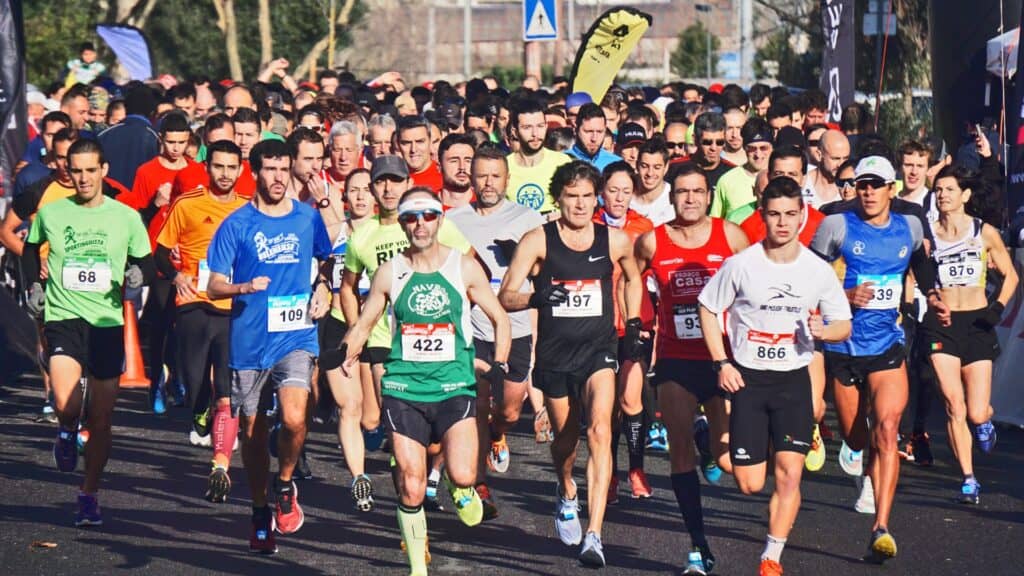The Boston Marathon holds a unique place in the world of marathons, as it stands as one of the few races that require runners to qualify.
This exclusivity adds to the allure and prestige of the event, making it a goal for dedicated runners around the globe.
The Boston Marathon is more than just a race; it’s a cherished tradition that holds a profound significance for the city and its people.
This iconic event has a rich history and a deep-rooted connection to the spirit of Boston. The bombings that shook the marathon in 2013 transformed the race into a symbol of resilience and unity.
The people of Boston, along with runners and supporters from around the world, regard this special day as a testament to the unwavering spirit of the city.
If you’re gearing up for your first Boston Marathon, you’re in for a treat with this enlightening article. It’s packed with priceless advice on everything from arriving in Boston to getting race-ready and nailing your hydration game.
We’ll even dive into a detailed breakdown of the marathon route, so you can tackle those unique challenges head-on and take your performance to new heights.
From the starting point in Hopkinton to the iconic finish line on Boylston Street, it’s a 26.2-mile(42.2-km) journey that epitomizes resilience and achievement.
The atmosphere is electric, making it an experience unlike any other.
Prepare to embark on an unforgettable journey as you tackle the historic and iconic Boston Marathon, the oldest marathon in the world. Known for its challenging course, this race demands careful preparation, especially for first-time participants like yourself.
While your training efforts have undoubtedly been rigorous (no last-minute runs will significantly enhance your fitness at this stage), there are strategic approaches and valuable insights you can adapt to ensure you approach the race like a seasoned pro.
By avoiding rookie mistakes (Get Better at Running: 10 Common Mistakes to Avoid) and implementing marathon-tested strategies (Boston Marathon Fuelling Guide: What to Eat and Where to Find It), you’ll be equipped to conquer the course with confidence and precision.
Get ready to unleash your inner champion!
Let’s dive in…

Arriving in Boston
To make the most of your Boston Marathon experience, it’s advisable to arrive in town on Thursday or Friday, even though the race takes place on a Monday.
Why? Because the weekend leading up to the marathon is jam-packed with exciting events you won’t want to miss.
One highlight is the Boston Marathon Expo, a bustling hub of activity that sets the stage for an unforgettable race day.
At the Expo, you’ll find yourself immersed in a world of running excellence.
Get ready to learn from elite runners and Boston Marathon legends through engaging seminars, while exploring an extensive collection of running gear from over 200 renowned companies like Adidas, Maurten, and Asics.
But you also do not want to spend TOO much time around the expo on your feet, as you can really cover a lot of distance around these expos, and the goal is to be off your feet as much as possible before race day.
Remember one golden rule: NOTHING NEW ON RACE DAY, whether it’s apparel, shoes, or nutrition, to prevent any unexpected discomfort. Nothing new on race day, whether it be nutrition or apparel.
It’s important to note that the location of the Expo may vary, so keep a close eye on the official Boston Marathon website for updates.
For instance, in 2023, the Expo took place at the John B. Hynes Veterans Memorial Convention Centre, located at 900 Boylston St., Boston, from April 14 to 16, 2023.
Before you head to the Expo, ensure you have your essentials in check. Bring along a valid photo ID and your bib pick-up card, as bibs will not be available for collection on race day.
Be sure to check out our article “Boston Marathon Expo 2026: How to get there, Times, and Parking” for detailed directions on how to reach the Expo and important parking information.
We’ve got you covered with all the essential details to ensure a seamless experience.
The Days Before the Race
The days leading up to the Boston Marathon race are crucial for runners as they finalize their preparations and ensure they are in peak condition for the monumental event.
To make the most of these final days, here are some key steps to take:
1. Tapering: Reduce your training intensity and volume to allow your body to recover and replenish energy stores. This tapering period ensures that you arrive at the starting line feeling fresh and ready to perform.
Marathon Tapering Method GUARANTEED To Have You At Your BEST Come Race Day
3. Hydration: Hydrate adequately in the days leading up to the race. Pay attention to your urine color, aiming for a pale yellow shade, indicating proper hydration.
4. Rest and Sleep: Prioritise quality sleep to aid in muscle recovery and optimize performance. Create a relaxing bedtime routine and ensure you get sufficient rest in the nights leading up to the race not just on race night. Because, likely, you won’t sleep well the night before the race due to nerves.
5. Race-Day Planning: Familiarise yourself with the race logistics, including the starting time, transportation, and any required documentation. Plan your pre-race meal and make sure you have all the necessary gear and supplies ready. Take a look at our comprehensive article: “How to Enter Boston Marathon 2026: Cost, How, and Who Can” where you can discover the starting times of the previous Boston Marathon. These timings can provide you with a general idea of when your designated wave is likely to begin.
6. Mental Preparation: Visualise yourself running a strong and successful race, focusing on positive affirmations, and maintaining a confident mindset. Engage in activities that help reduce stress, such as deep breathing exercises or listening to calming music.
Hydration Strategies for Your First Boston Marathon
The Boston Marathon race is a grueling test of endurance, and proper hydration plays a vital role in your performance and overall race experience. As you embark on this monumental journey, here are some essential hydration strategies to keep in mind:
Before the Race
- Electrolyte Boost:
Instead of relying solely on water, incorporate an electrolyte drink into your pre-race routine. This will help enhance your blood plasma volume, maintaining the right balance of electrolytes essential for peak performance. Choose a quality electrolyte drink that provides a mix of sodium, potassium, and magnesium.
- Timing Matters:
On the night before the race, make sure to consume an electrolyte drink to promote proper hydration. This allows your body to absorb the electrolytes and gradually boost your blood plasma volume, ensuring you start the race in an optimally hydrated state.
- Strategic Hydration:
Aim to drink around 2–3 milliliters of fluid per pound of body weight at least 4 hours before the race begins. This approach helps ensure adequate hydration without overwhelming your system or causing discomfort.
Calculate your fluid intake based on your body weight to determine the appropriate amount.
Everything You Need To Know About Electrolytes & Salt Tablets During A Marathon
While salt tablets are typically reserved for extreme endurance events held in hot and humid conditions, most marathon runners can rely on sports drinks to meet their electrolyte needs.
Adding a pinch of salt to your drink can further enhance electrolyte balance.
Sports drinks generally contain a sodium concentration ranging from 23 to 69 milligrams per decilitre, providing sufficient electrolyte replenishment for regular marathon runners.
However, if you wish to explore additional electrolyte replacement options, turning to food sources can be an effective approach. Consider incorporating salty snacks like biscuits, nuts, or pretzels to address electrolyte requirements.
Certain circumstances may warrant a more aggressive approach to electrolyte intake.
Low electrolyte levels can manifest through symptoms such as:
- Nausea,
- Excessive tiredness,
- Weakened muscles, and
- Spasms.
If you experience any of these signs, it’s advisable to consider electrolyte supplementation, adding salt to your water, and boosting your intake of electrolyte-rich plant foods like bananas, greens, nuts, and seeds.

Hydration During the Race:
To optimize your performance and prevent any potential issues like hyponatremia, it’s crucial to your hydration strategy for the Boston Marathon race.
Sodium loss in sweat varies from person to person, so simply relying on water may dilute your sodium levels and negatively impact your results.
While there are designated drink stations along the course, it’s important to note that you don’t need to stop at each one.
Instead, consider the fluid intake you’ve practiced during your long training runs and aim to replicate that during the marathon, making adjustments based on your thirst level and the environmental conditions.
To stay on track, only pause at drink stations and for fuel, as you’ve planned in your training. This helps maintain your pace and rhythm without unnecessary interruptions. Drink to thirst is a big component of this.
Recovery Hydration and Fuelling:
Proper recovery fuelling plays a vital role in promoting muscle recovery and restoring glycogen stores.
It is recommended to consume a post-race recovery option containing carbohydrates and protein within 30 minutes of crossing the finish line.
This doesn’t necessarily have to be a full meal, as some individuals may find it challenging to eat solid food immediately after the race.
For those seeking convenience and effectiveness, opting for a liquid form of nutrition, such as chocolate milk, can be a smart choice to kick-start the recovery process.
Research suggests that chocolate milk serves as a cost-effective and beneficial alternative to expensive recovery products.
A study showed that it can help extend the time to training exhaustion and improve muscle repair, both of which are crucial for effective recovery after exercise.
To delve deeper into the science and gain more insights, you can watch our informative video: “Is Chocolate Milk A Great Recovery Drink For Runners?”
Hydration is another crucial aspect during the recovery period, so it’s important to continue drinking fluids regularly.
While consuming alcohol post-race is not necessarily detrimental to recovery, it’s important to be mindful of the effects.
Moderate alcohol consumption, such as having one beer, is generally acceptable. However, excessive intake, particularly more than two beers, can lead to dehydration and potentially hamper the recovery process.
Excessive alcohol consumption not only impairs the uptake of important nutrients like muscle glycogen and amino acids but can also disrupt sleep quality, hinder adaptation, and elevate heart rate.
These effects can significantly impede your body’s ability to recover effectively after a race or intense training session.
To optimize your post-race recovery, it is advisable to limit alcohol intake, especially during periods of heavy training or leading up to important races. Prioritizing quality sleep, adequate hydration, and proper nutrition are essential components of the recovery phase.
If you choose to have a celebratory drink after a race, it’s best to moderate your alcohol consumption and ensure you replenish fluids lost during the race.
Opting for non-alcoholic hydrating beverages like water or sports drinks can be a wiser choice for supporting optimal recovery.
Remember, recovery is an integral part of the training process, and taking care of your body during this phase can have a significant impact on your overall performance as a runner.
By finding a balance between enjoying alcohol and prioritizing your recovery needs, you can effectively support your body’s healing and adaptation processes, ultimately enhancing your running performance in the long run.
Now that we have covered the essential aspects of hydration for your first Boston Marathon, let’s turn our attention to the exhilarating Boston Marathon route.
The Boston Marathon Route Description
The Boston Marathon Route is a 26.2-mile (42.2-km) course that starts in Hopkinton, Massachusetts, and finishes in Boston. The course has a net elevation loss of 459 feet (139.9 meters), with the highest point at the start and the lowest point at the finish.
The first half of the course primarily consists of gently rolling hills, with a notable climb occurring before Wesley.
The second half of the course is known for its challenging hills, particularly the famous Newton Hills spanning roughly 25-30 km. The final stretch includes the feared Heartbreak Hill. However, the last few kilometers are mostly gentle downhill, leading runners to the finish line.
The Boston Marathon route is considered a difficult course, with its rolling hills and challenging terrain. The course records for men and women are 2:03:02 and 2:19:59, respectively.
Start Line to Mile 1
The race begins with an exhilarating downhill start, but runners should resist the urge to go too fast. There’s a slight uphill around 800 meters in, catching some off guard.
Mile 1 to Mile 4
The course continues with rolling hills and transitions from rural to commercial scenery. Runners pass notable landmarks like the clock tower and encounter Massachusetts logos like Dunkin’ Donuts and the “T” for Ashland Commuter Rail station.
Mile 4 to Mile 10
The course enters Framingham and features mostly flat terrain and minor rolling hills. Runners will pass through industrial areas and enjoy the scenic Lake Cochichuate. The historic district of Natick makes a nice switch from commercial and industrial landscapes.
Mile 10 to Mile 16
This section takes runners through Natick Centre, where significant crowds gather. The mile starts with an uphill climb and then rolls downhill. As Wellesley College approaches, runners experience the famous Wellesley College screaming tunnel.
Mile 16 to Mile 21
This is where the course becomes challenging with the start of the Newton Hills. Runners climb and descend for about nine miles, including the notable Heartbreak Hill. Boston College’s energetic supporters make their presence known, encouraging along the way.
Mile 21 to Mile 24
As the course enters Brookline, runners face trolley tracks and a quarter-mile climb. Descending along Beacon Street, they pass through Brookline’s neighborhoods and catch a glimpse of Boston’s Citgo sign.
Mile 24 to Mile 26.2 (Finish Line)
The final stretch begins with a slight descent, offering a view of Fenway Park. Runners pass through enthusiastic crowds at “the turn on Hereford” and make their way to Boylston Street, where the finish line awaits near the Boston Public Library and Copley Square.

Should You Be Taking An Entire Day Off For Recovery?
At Coach Parry, we strongly recommend dedicating one full day per week to rest and recovery. This practice emphasizes the significance of mental rejuvenation rather than solely focusing on physical recuperation.
For instance, including a swim session on your designated rest day can be beneficial for your overall recovery process.
However, our experience has shown that having a day completely free from training-related thoughts and scheduling can immensely contribute to both your mental and physical restoration.
We encourage you to watch our informative video, where we discuss the vital role of both physical and mental recovery in the life of a runner.
They provide valuable insights and guidance on how to prioritize rest and strike a balance between training and recuperation.
By implementing a dedicated day for rest, you allow yourself the opportunity to recharge not only your body but also your mind. It offers a break from the demands of training, allowing you to fully recover and approach your workouts with renewed energy and enthusiasm.
Why Are Recovery And Nutrition As Important As Running?
Neglecting recovery increases the likelihood of injury and illness and can hinder our performance.
When we exercise, we cause damage to our system at a low and healthy level. Recovery is when the body repairs this damage and makes improvements so that we can withstand more the next time we exercise.
These small improvements are what lead to increased fitness, speed, and strength. Without adequate recovery, we do not allow for the full repair and compensation of the damage caused by training.
Proper nutrition is also important for recovery, as it provides the body with the nutrients it needs to repair and rebuild muscle tissue.
A diet that includes a balance of carbohydrates, protein, and healthy fats can help replenish glycogen stores, repair damaged muscle tissue, and reduce inflammation.



Comments are closed.